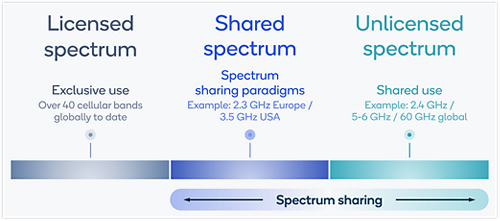Big 5G Conference: 6G spectrum sharing should learn from CBRS experiences
Spectrum sharing is a methodology that allows multiple wireless networks to access the same frequency band dynamically and efficiently. It can reduce the spectrum scarcity issue and enable more wireless applications and services, but also requires careful coordination and management to avoid interference and ensure fair access.
Examples of spectrum sharing techniques include Licensed Shared Access (LSA), which uses a regulatory framework to permit licensed users to share spectrum with incumbent users, Dynamic Spectrum Access (DSA), which enables wireless networks to sense and adapt to the spectrum environment, and Spectrum Aggregation, which combines multiple spectrum bands or channels into a larger bandwidth. LSA can be used by mobile operators to access spectrum that is not used by TV broadcasters, DSA can be employed by cognitive radio networks to detect and avoid channels occupied by primary users, Spectrum Aggregation can be used by 5G networks for coverage and speed.
The wireless telecom industry has to take a “concerted look at revolutionizing spectrum sharing” and to take a closer look at the lessons learned from CBRS spectrum sharing [1.], which took about a decade to be successfully implemented, according to Andrew Thiessen, chair of the spectrum working group at the Next G Alliance who was speaking at the Informa Big 5G conference panel session in Austin, TX. He opined that the industry needs to be pushing ahead with spectrum sharing technologies and techniques at speeds similar to the innovations that are being applied to smartphones.
Note 1. Citizens Broadband Radio Service (CBRS), which allows for dynamic spectrum sharing between the Department of Defense and commercial spectrum users. The DOD users have protected, prioritized use of the spectrum. When the government isn’t using the airwaves, companies and the public can gain access through a tiered licensing arrangement. This means the DOD can use the same spectrum for its critical missions while companies can use it for 5G and high-speed Internet deployment.
“Innovative spectrum sharing frameworks are key to unlocking additional bandwidth for wireless connectivity across the country,” Deputy Assistant Secretary of Commerce for Communications and Information April McClain-Delaney said. “The success and growth of the CBRS band shows the promise of dynamic spectrum sharing to make more efficient use of this finite resource.”
………………………………………………………………………………………………………………………………………………..
Joe Kochan, executive director of the National Spectrum Consortium, agreed that spectrum sharing for 6G does present challenges as it faces a wide range of commercial users, federal users and non-federal users, as well as different types of technologies, such as radar. That elicits a need for the industry to build new tools and to get more creative about how that spectrum can be shared.
The Biden administration’s National Spectrum Strategy will “lay the framework” to get everything moving, said Derek Khlopin, deputy associate administrator, spectrum planning policy, at the NTIA. “We’re tech and application-neutral. But the better we understand, the better we can plan.” he explained.
“We’ve started listening, to be frank,” Khlopin said. “But it’s not necessarily the role of the government to figure all of this out. We need help, so we’re working closely with industry, with academia and others. Spectrum sharing is here to stay between federal and non-federal users,” he added.
Khlopin was asked about NTIA’s exploration of the 7GHz band and its potential for 6G. “It’s a very complicated band,” he said. “There’s a lot there … We’re aware of the industry interest there.”
Thiessen said one challenge for 6G will be a lack of contiguous spectrum. He believes that 6G will likely be made up of a lot of pieces of spectrum, and those pieces will likely need to be targeted to specific use cases. However, that presumption is premature as neither 3GPP or ITU-R WP5D has started any serious work on defining 6G specifications. That is why all the buzz about 6G is irrelevant at this time.
References:
https://www.linkedin.com/advice/1/how-can-wireless-network-coexistence-interference
https://ntia.gov/blog/2023/innovative-spectrum-sharing-framework-connecting-americans-across-country
https://www.lightreading.com/6g/spectrum-sharing-will-be-key-to-unlocking-6g/d/d-id/784884?
Vodafone tests 5G Dynamic Spectrum Sharing (DSS) in its Dusseldorf lab



